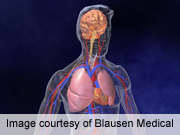
SATURDAY, May 10, 2014 (HealthDay News) — Some reminders about detecting and treating strokes are offered as Stroke Awareness Month continues.
Dr. Henry Woo and Dr. David Fiorella, co-directors of the Stony Brook University Cerebrovascular and Stroke Center, say the most important thing is to remember the FAST rules about stroke symptoms:
- F — face drooping
- A — arm weakness
- S — speech difficulty
- T — time to call 911
“Speed of treatment is crucial,” said Woo, an endovascular neurosurgeon and professor of neurological surgery and radiology at Stony Brook’s School of Medicine, in a university news release. “People are seeking treatment faster and, more critically, at the right place — a health care facility that’s been certified as a primary stroke center.”
If you suspect you’re having a stroke, call 911. “Alert the operator that you are having symptoms of a stroke,” added Fiorella, a neurointerventional radiologist and also a professor of neurological surgery and radiology at Stony Brook, in the news release. “Ask to be taken to a primary stroke center, where appropriate and efficient protocols are in place, the latest interventions are available 24/7 and your medical team is experienced and highly trained.”
Fiorella said it’s important to know that there are two kinds of strokes — ischemic (a vessel becomes blocked and can’t bring proper blood flow to parts of the brain) and hemorrhagic (a vessel ruptures and bleeding begins in or around the brain).
Ischemic strokes are the most common, Fiorella said. “Both kinds can be either acute or chronic. Acute stroke generally signifies the sudden onset of symptoms, indicating that you are indeed having a stroke. Chronic stroke indicates the presence of factors that could eventually cause a stroke, such as a blockage or an un-ruptured aneurysm. In these cases, if detected in time and treated, stroke can be prevented.”
Ischemic stroke symptoms include paralysis (especially on one side of the body), speech and visual disruptions, weakness throughout the body and loss of consciousness.
“People also may experience more subtle signs, such as numbness and tingling, which may indicate what is commonly called a mini-stroke, or transient ischemic attack,” Woo said.
Transient ischemic attacks “tend to quickly resolve themselves, but they are often a precursor to a major stroke, so it’s important to take them seriously and see a doctor if you suspect you have had one,” he added.
Hemorrhagic stroke can be dramatic, including a sudden and immensely painful headache unlike any other.
More information
For more about stroke, try the U.S. National Library of Medicine.
Copyright © 2025 HealthDay. All rights reserved.

